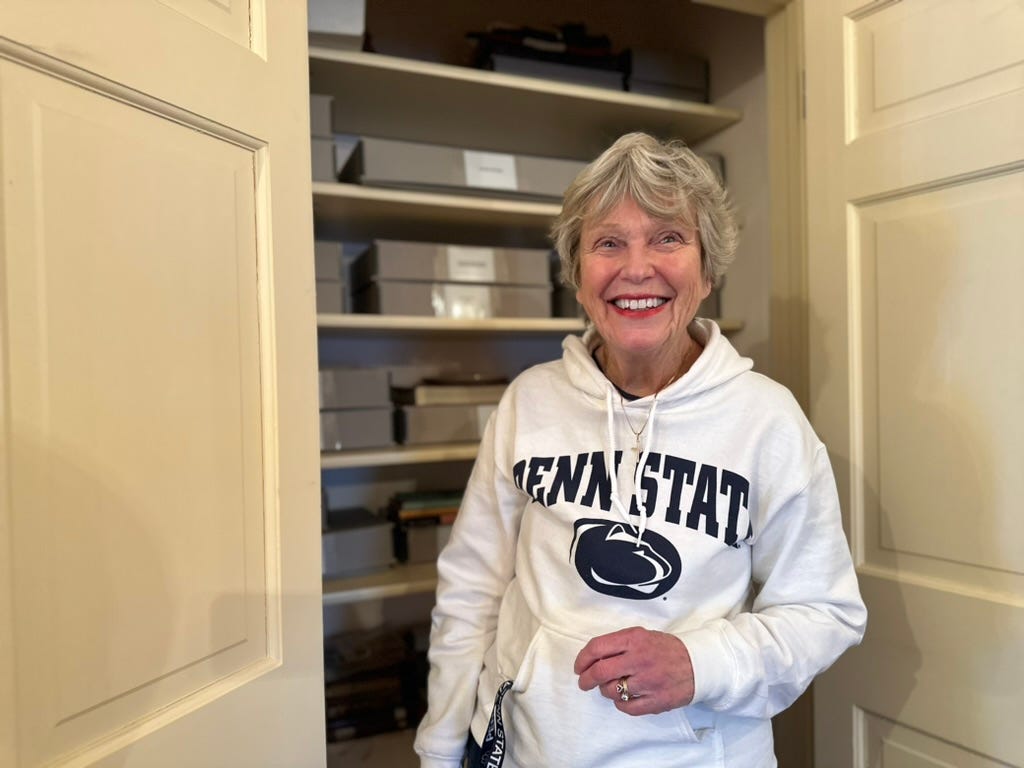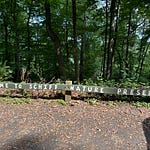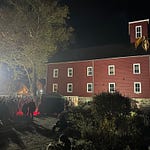(Listen on your favorite podcast player: iTunes, Spotify, Overcast, HeartRadio, Amazon Music)
One of the oldest aerial photographs of Mendham highlights a specific building1.
Maybe you’ve driven by it picking up your kids from school, or you’ve been in it during a Sunday service.
It’s a white steepled church on a hill. And regardless of your spiritual beliefs, it stands as one of the iconic symbols of Mendham.
So when my producer Katie and I went looking for information on the history of the First Presbyterian Church of Mendham, also known as Hilltop Church…we found something a bit confusing.
In several older books written about Mendham history we came across references to not only this FIRST church…but also a second presbyterian church of Mendham.
(And listeners, in case you’re not aware, currently, in 2024, there is no Second Presbyterian Church of Mendham)
We dug a little deeper and discovered that this second church formed, in 1859, from a breakup of the first church.
And whenever there is a schism, there is a story.
So we wondered…what event could have caused a congregation that had been around for so long (over 100 years at that point) to fracture? Was it geological? Political? Social? A lover’s quarrel?
—
(Theme)
This is the story of two versions of a church.
The story behind why…in 1859…it decided to split.
Welcome to Hometown History. A series about the iconic places and events that make a town someplace people call home. Stories that people can tell to their friends old and new about the place they live, did live, or will live: In my case, Mendham, New Jersey.
—
Now, I know this is the second time we’re talking about the church on this podcast. But that’s because The First Presbyterian Church of Mendham held a commanding position in the life of the town, both physically and culturally, since the day it opened its doors in 1745. In fact, according to English law and tradition, you didn’t even have a permanent community until you established a church2.
And Hilltop Church is much more than just a place of worship for Mendham. Ask any longtime local, churchgoer or not, and they’ll probably have a story to share about Hilltop.
Wait this is great…There’s the one about how Ms. Martha Drake, nee Thompson, sat in church near a window during a violent storm and was struck by lightning3.
(Thunder crack)
Or how Rev. Philip Courtlandt Hay was run out of town for preaching too heavily against the evils of alcohol4.
And of course there’s the story of how the sanctuary was turned into a hospital for soldiers stricken with smallpox during the Revolutionary War5. Twenty-seven of them are buried in the cemetery there.
The point is, there isn’t a resident of Mendham who doesn’t know something about the history of The First Presbyterian Church.
But what about the Second Presbyterian Church? The one that was created in 1859 from a split at Hilltop? It dissolved in 1904, so it’s not as if there are local residents alive today who can tell us all about it.
There are several books written by former residents of the town. Our Mendham, by Ella Mockridge; Through the Years in Mendham Borough, by Kate Emmonds; The Mendhams, by Martha Hopler and others.
But none of them dedicate more than a page or two to this particular chapter of Hilltop’s history.
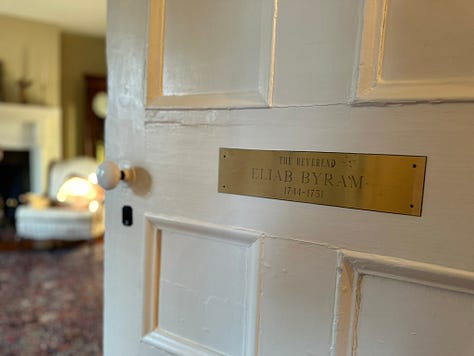


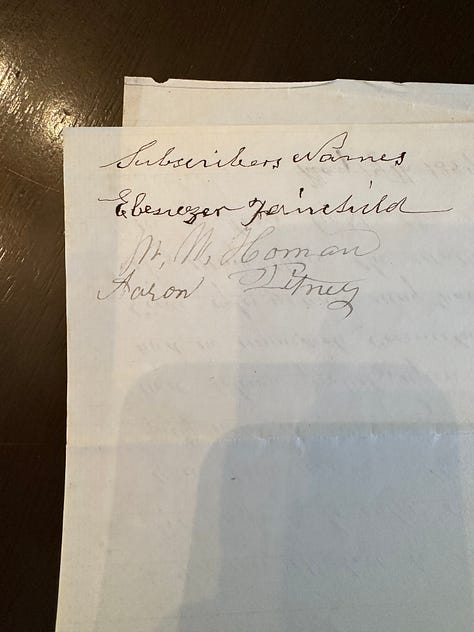
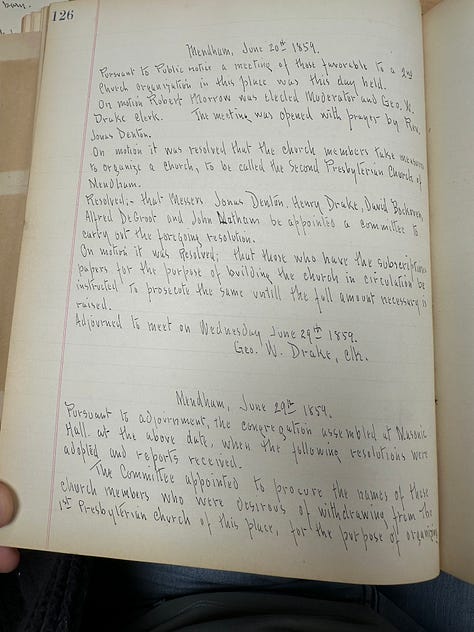

The archives of the Mendham Borough Library were able to tell us a little more about the second church as it existed, but not a ton of detail about why it split.
So we reached out to Hilltop itself - wasn’t there a trove of records we could take a peek at?
(Door squeak)
They said yeah, come on over to our library.
KATIE: Hello…?
Uhh it turns out that the library isn’t actually in the physical church itself.
KATIE: Hello…?
It’s at Hilltop House, next door to the elementary school, where the Hilltop Nursery School is located.
KATIE: “Oh my god I just broke into a church…”
Yeah…we should’ve figured that out sooner.
(Door squeak)
By the way, the building that Katie just broke into here – well, technically she got in through a side door that was open – that church, the one we see today was not the first church to occupy this little hilltop.
(Music)
The first was built in 1745. It was a modest, square, south-facing structure built by John Cary, a carpenter and friend of one of Mendham’s main forefathers - Ebenezer Byram.
Now the Byram family, as we know, had a big role in the early history of Mendham6. Ebenezer Byram was the proprietor of The Black Horse Inn, a place that was a stop-over for weary travelers heading west from New York City.
Before Hilltop was Hilltop, the religious residents of the area met together at a general meeting house for worship. That structure has since been torn down, but it once stood just up the hill from the Ralston General Store.
Ebeneezer’s second son, Eliab Byram, became the pastor there in 1744. When “the meeting house” was no longer suitable for varying worshippers, Ebeneezer proposed building a proper church closer to his Inn.
Very quickly a place that was once just a stop along a journey elsewhere became the destination. With a church, Mendham was now someplace to call home.
When my producer Katie and I finally figure out where we’re supposed to be, we meet up with Marilyn Willet - a long time parishioner of Hilltop Church.
Marilyn isn’t an expert on Hilltop’s history - no one alive today is really. That’s what makes it so hard to find out what happened when the First Presbyterian Church of Mendham split.
But Marilyn does have access to the church library, where there are tons of books about church history.
MARILYN: But this book, this is Helen Wright's book. And there's not another book written with so much history of the church in it.
Marilyn hands me a book published in 1937 by Helen Martha Wright, a local historian, genealogist, and teacher78. Her book about Hilltop Church is a comprehensive, albeit, pretty mundane recitation of facts. Which pastors were here when and for how long. Records of marriages, baptisms and deaths, etc.
But on the topic of the splitting up of Hilltop Church - possibly the biggest thing to happen to the church since its founding - Wright’s book offers frustratingly little.
WOMAN: “Reliable authority asserts that the slavery question, then agitating the land was the principle cause that brought about the organization of the 2nd church, the pastor and that faction which withdrew to the new society being in sympathy with the cause of Freedom.”
Woah… soooo, not a lover’s quarrel.
In search of more concrete details as to what about “the slavery question” caused this rift, Marilyn shows us upstairs and unlocks a closet full of meticulously organized files.
RYAN: Oh these are the archives
MARILYN: Yeah... I think that's the flag, that was the Civil War flag, I think..
RYAN: What do you mean?
MARILYN: I mean, its of the age of the Civil War.RYAN: What!?
The trouble indeed seems to have begun, at least publicly, right around 1859, on the precipice of the Civil War.
Now, it might surprise you to hear that slavery was a hotly debated issue in New Jersey in 1859. Weren’t we all taught in school that the northern states were against it and the southern states were in favor? Well, like with most things, when you dig into the history, there’s a lot more nuance to it.
MICHAEL: You know, there wasn't widespread slavery in this part of New Jersey. It was not for a lack of trying…
Michael Snyder is a local New Jersey historian with expertise in the antebellum period of Morris County.
MICHAEL: But what made slavery different in this area, as to say in the South, was it wasn't self-sustaining because there weren't any real cash crops around here. There was no cotton, there was no tobacco, none of those things.
Because New Jersey’s core economy wasn’t reliant on slave labor, the state wasn’t prompted to act in any way to address slavery, certainly not on moral grounds.
MICHAEL: The opinion was predominantly that it was a legal issue, and they didn't want to interfere with it.
And who was the “they” in this context?
MICHAEL: The two newspapers that were printed in Morristown, one was a Republican newspaper, one was a Democrat newspaper. And neither one of them had had the opinion that slavery should end immediately. If anything, it was that it's going to die its own natural death if it doesn't spread anymore than it does.
They get more upset at, say, abolitionists for stoking the ideas of slave insurrections and things like that. Like, some of these articles are saying, ‘if these abolitionists would just leave well enough alone, we wouldn't have the problems that we have.’
The political climate in Morristown as shown through these local papers suggested that people felt “Sure, slavery is bad and it shouldn’t spread. But agitating the populace and calling for war to end slavery? That’s almost worse!”
At the dawn of the 19th century, despite all its hesitancy, New Jersey took a step towards freeing its enslaved people - in fact, it was the last northern state to do so.
The Gradual Emancipation Act of 18049 allowed the children of enslaved Blacks born after July 4, 1804 to be free, but only after they reached the age of 21 for women and 25 for men.
MICHAEL: So that kind of set off this push to not immediately free enslaved people within New Jersey, but to give them a legal process where eventually they would be free.
So the question of slavery in New Jersey was finally on a decades long journey towards resolution. A satisfying compromise for some, but not for those rabble rousing abolitionists despised by the Morristown newspapers. Abolitionists like Rev. Theordore F. White.
Rev. White was pastor of Hilltop Church in 1859. And he just so happened to be a firebrand for the cause of abolition.
Born in New York City in 1830, White graduated from New York University in 1849 and from the Union Theological Seminary in 1853. He was ordained in 1854 and was posted to the little church in Mendham, a young unmarried man fresh from theological training.
The Rev. Mr. White was a strong abolitionist. He wasn’t the first pastor of Hilltop Church to have views against slavery. But it seems he wasn’t as, erm, tactful as his predecessors.
A newspaper clipping from around that time mentions that Rev. White was well-known for his - ahem - alternative viewpoints.
MAN 1: “We do not need to say to a solitary person who has ever heard Rev. Theodore R. White in his pulpit or on the platform that his lecture last Wednesday evening was one of the best of the course. Undoubtedly, many of the points sounded harsh, unpleasant, extreme to conservative ears. Nobody who knows him could have expected anything else. He is, and has been one of the leaders and educators of pulpit opinion – not a man who simply swims with the current.”
So perhaps White’s style in the pulpit rubbed some folks the wrong way. Now throw in the fact that the United States was on the brink of a civil war. And here in Morris County, the local newspapers touted patience over action.
(Storm sounds)
Into this gathering storm Rev. White threw a lightning bolt, electrifying the community.
The reverend brought a black man into the pulpit with him.
(Thunder crack)
MARILYN:. …And that did it for half of the congregation because this was quite a slave owning area.
At Hilltop, a number of influential parishioners either were, or had been, slave owners; others opposed slavery.
And this little stunt Rev. White pulled in the spring of 1859 was the event that pushed these two groups further apart.
Now it’s hard to get a full picture of exactly what happened over the course of the next year at Hilltop. We didn’t find a comprehensive record of events surrounding the split of the First Presbyterian Church at Mendham.
The details were never fully recorded either due to negligence, or perhaps on purpose, to keep what was admittedly a dark time in the history of the church out of the public record. I mean, hey, it wouldn’t be the first time - the Catholic Church perfected this strategy.
Here’s what we did find:
Records held at the Mendham Borough Library from June and July of 1859 discuss the passing of resolutions and formation of committees with respect to forming a Second Presbyterian Church of Mendham.
Members discussed who would leave and how they should do it. And they took steps to find a place in town for Mendham’s Second Presbyterian Church.
MARILYN: Look at that handwriting too…
Marilyn pulls some files out of storage labeled “Second Presbyterian Church”. Among them is a document that looks to be something original from 1859. The cursive is loopy to the point of being almost illegible.
MARILYN: May 19th, 1859 this was written.
KATIE: This says “Protest” on the top.
Now, there’s a document we hadn’t seen before.
RYAN (reading): “We, the undersigned, members of the church and Congregation of Mendham…”
In opposition to the actions taken by White and his supporters to leave and start a new church, it appears as if a few members opposing the split drew up an official letter of protest.
In it the authors lay blame for the church’s troubles squarely on Rev. White’s shoulders.
RYAN: Man this is so hard to read. “...of Reverend White, has by his conduct…”
MAN 2: “Rev Theodore F. White has by his conduct, and also by his remarks, within the congregation, and without or beyond it’s bounds, in the Pulpit and out of it, been himself the principal cause of the difficulties or troubles, that have arisen and disturbed the church and congregation…”
MARILYN: Yeah because White was against slavery.
And at the bottom of the document, are three names:
MAN 2: “…Ebenezer Fairchild, M. M. Homan, Aaron Pitney.”
Ebenezer “Boss” Fairchild was the father of Ezra Fairchild, who you may recall was the founder of one of Mendham’s earliest schools. Hmm, interesting family.
And perhaps the name Pitney sounds familiar too. James Pitney and his family were large landowners in Mendham dating as far back as the 1720s. And historical records indicate that the Pitney family had owned slaves in the early 1800s. Which wouldn’t have been that unusual, given that they owned one of the largest farms in Mendham10.
Now whether this official “protest” document was submitted or acknowledged or acted upon…we just don’t know. But by 1860 the congregation of the Second Presbyterian Church in Mendham had established a new place of worship…right down the street from Hilltop church.
(Music)
Picture this: On Sunday morning, from atop the hill where the first church sat, you could look down towards the center of town and see the second church, a little white clapboard building, right where Bailey’s Funeral Home now stands. Friends and neighbors who once gathered together in pews at Hilltop, filing into the little white church's doors, separated by just a few blocks, and by deep ideological differences. And no one knew if or when those differences would be repaired.
As it turns out, Hilltop church needed more than just spiritual repairs in 1859.
As I mentioned earlier, there have been a few iterations of the building known as Hilltop Church. The first, the little square building constructed by John Carey, friend of Ebenezer Byram. That building served the community until 1816, when it was torn down to make way for a bigger one. Then in February of 1835, that church burned to the ground.
The third structure built served as Hilltop Church until it too burned to the ground…in February 1859. Just months before the schism with Rev. White ruptured.
In its place, a new church was erected - the one that stands today.
As for Rev. Theodore White, while he supported and helped organize the formation of the Second Presbyterian Church, and even preached from its pulpit, he declined to be installed as its regular pastor11. Maybe he felt his reputation was tarnished by the ordeal. Or perhaps he felt that the community of Mendham could heal better from these events without him.
Because Mendham did move on – now with TWO Presbyterian churches. For thirty years the Second Presbyterian Church served a small but dedicated congregation.
But, what happened to it? Well, the quick version of events says that in the years after the Civil War12, as the issue of slavery faded into memory and a new generation took over, the two churches made up, and the congregation was mended.
(p.s. This isn’t why they call it Mendham”)
The extended version of events was…a little spicier. But that’s a story for another time.
—
This episode was written and produced by Ryan Ross and Katie Feather. It was mixed and edited by Katie Feather. Our theme Music is La Danse Timide by Howard Harper-Barnes. Special thanks to Michael Snyder, Marilyn Willet, Patrick Williams, Rev. Scot McCachren, Patricia Maio, and Bill Mauer for information and guidance.
Bibliography:
Mockridge, Ella. (1961). Our Mendham
Emmonds, Kate. (1973). Through the Years in Mendham Borough. Self-Published.
Martha G.; Edward W. Roessler & Wallace G. West Hopler (1964). The Mendhams. Publisher: Mendham Township Committee.
Foster, Janet W. (1986). Legacy Through the Lens: A Study of Mendham Architecture. Mendham Free Public Library.
Wright, Helen Martha. (1938). The First Presbyterian Church of Mendham, Morris County, New Jersey and its vital records. Self-published.
Legacy Through the Lens, pg 7
Two Hundred Fifty Years on The Hilltop, pg 1
Hilltop, pg 77
Hilltop, pg 88
Hilltop, pg 9
https://historicmendhamtwp.com/ebenezer-byram/
https://onlinebooks.library.upenn.edu/webbin/book/lookupname?key=Wright%2C%20Helen%20Martha
https://babel.hathitrust.org/cgi/pt?id=nyp.33433085431686&seq=9
https://nj.gov/state/historical/his-2021-juneteenth.shtml#:~:text=It%20allowed%20for%20the%20children,or%20waiting%20to%20be%20freed.
https://pitneyfarm.org/
https://babel.hathitrust.org/cgi/pt?id=nyp.33433085431686&seq=35
Slavery was not declared officially illegal in New Jersey until 1866 by way of a state constitutional amendment.






